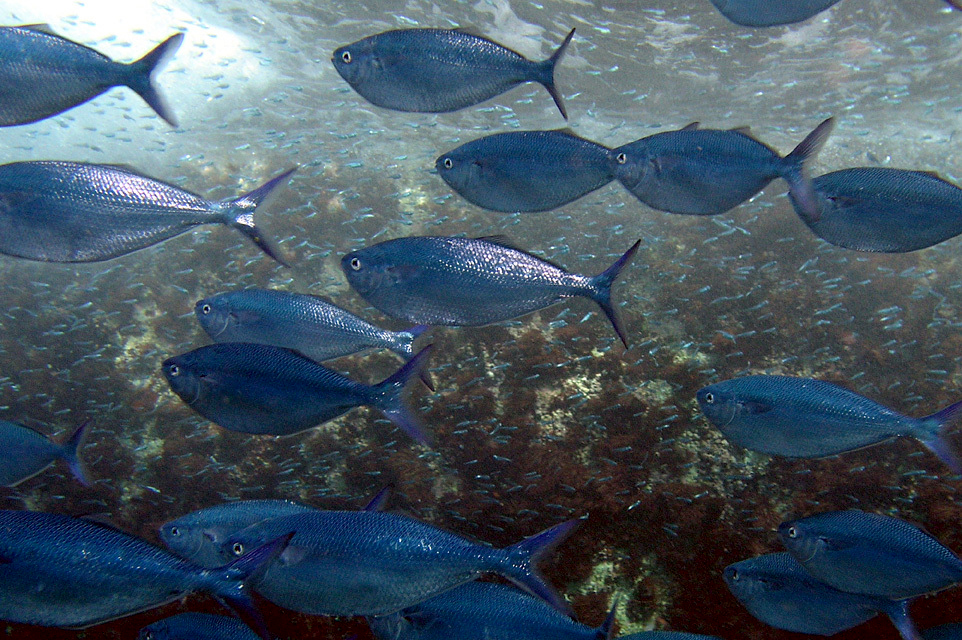Grey Knifefish, Bathystethus cultratus (Bloch & Schneider 1801)

A school of Grey Knifefish, Bathystethus cultratus, at South Solitary Island, New South Wales, April 2006, depth 20 m. Source: Sascha Schultz / iNaturalist.org. License: CC by Attribution-NonCommercial
A compressed silvery-grey to deep bluish "sweep" with a rounded blade-like silvery ventral profile, two dorsal fins comprising a series of isolated spines followed by a long-based soft fin, and a low scaly sheath along the bases of the second dorsal and anal fins. The species lacks teeth, has a small mouth, low dorsal and anal fins, small pectoral fins and a forked tail.
Fast swimming schools of Grey Knifefish feed on plankton near the surface.
Grey Knifefish, Bathystethus cultratus (Bloch & Schneider 1801)
More Info
|
Distribution |
Julian Rocks to Port Stephens, New South Wales; also the Lord Howe Province and Norfolk Island in the Tasman Sea. Elsewhere the species occurs in northern New Zealand. Fast swimming schools feed on plankton in near surface waters. |
|
Similar Species |
|
|
Etymology |
The specific name is from the Latin cultratus (= knife-shaped) in reference to the knife-like shape of this species. |
|
Species Citation |
Cichla cultrata Bloch & Schneider, 1801. Systema Ichthyologiae: 343. Type locality: Norfolk Island. |
|
Author |
Bray, D.J. 2022 |
|
Resources |
Grey Knifefish, Bathystethus cultratus (Bloch & Schneider 1801)
References
Allen, G.R., Hoese, D.F., Paxton, J.R., Randall, J.E., Russell, B.C., Starck, W.A., Talbot, F.H. & Whitley, G.P. 1976. Annotated checklist of the fishes of Lord Howe Island. Records of the Australian Museum 30(15): 365-454 figs 1-2
Bloch, M.E. & Schneider, J.G. 1801. Systema Ichthyologiae Iconibus ex Illustratum. Berlin 584 pp. 110 pls. See ref at BHL
Francis, M. 1993. Checklist of the coastal fishes of Lord Howe, Norfolk, and Kermadec Islands, southwest Pacific Ocean. Pacific Science 47(2): 136-170 figs 1-2
Francis, M.P. 2019. Checklist of the coastal fishes of Lord Howe, Norfolk and Kermadec Islands, southwest Pacific Ocean Version: 2019.1 https:doi.org/ 10.6084/m9.figshare.c.4428305
Francis, M.P., Worthington, C.J., Saul, P. & Clements, K.D. 1999. New and rare tropical and subtropical fishes from northern New Zealand. New Zealand Journal of Marine and Freshwater Research 33: 571-586.
Hoey, A.S., Pratchett, M.S., Johansen, J. & Hoey, J. 2014. Marine ecological survey of Elizabeth and Middleton Reefs, Lord Howe Commonwealth Marine Reserve. Final report produced for the Department of the Environment. ARC Centre of Excellence for Coral Reef Studies, James Cook University, Townsville QLD. 101 pp. https://doi.org/10.13140/RG.2.1.2517.0408
Knudsen, S.W. & Clements, K.D. 2013. Revision of the family Kyphosidae (Teleostei: Perciformes). Zootaxa 3751(1): 1-101.
Ogilby, J.D. 1889. Notes on some fishes new to the Australian fauna. Proceedings of the Zoological Society of London 1889: 151-158. (described as Platystethus guentheri, type locality Lord Howe Island) See ref at BHL
Trnski, T. & Knudsen, S.W. 2015. 192 Family Scorpididae. pp. 1324-1328 in Roberts, C.D., Stewart, A.L. & Struthers, C.D. (eds). The Fishes of New Zealand. Wellington : Te Papa Press Vol. 4 pp. 1153-1748.
Waite, E.R. 1904. Additions to the fish-fauna of Lord Howe Island. No. 4. Records of the Australian Museum 5(3): 135-186 fig. 32 pls 17-24 https://doi.org/10.3853/j.0067-1975.5.1904.1053
Waite, E.R. 1909. A list of the known fishes of Kermadec and Norfolk Islands, and a comparison with those of Lord Howe Island. Transactions of the New Zealand Institute 42: 370-383 See ref at BHL




